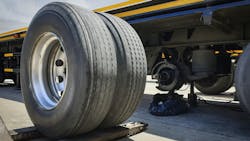Key takeaways:
- Proper installation is crucial for the safe assembly of truck tires. Technicians must follow the RIST Procedure to ensure the right torque and clamping force.
- Performing torque checks after 50 to 100 miles is vital to detect any loosening of wheels and prevent accidents caused by fatigued studs.
- Responsibility for safety is shared among technicians, dealers, and fleet operators, all of whom must maintain standards and conduct checks to reduce the risk of wheel-off incidents.
Installing a commercial truck tire wheel or rim assembly seems like nuts and bolts to most people. In most cases, a hydraulic jack and impact wrench with a 33-mm impact socket is all you need. The advancements in cordless technology have rendered the air compressor unnecessary, making it easier for anyone to install the assembly or assemblies on the end of the axle.
In the U.S., there are about 13.5 million registered commercial motor vehicles. About 2.97 million are tractor-trailers, and 10.5 million are single-unit trucks. If each type of vehicle had 18 and 6 tire/wheel assemblies, respectively, that’s about 126.46 million truck tires and wheels on the ground. If the average semi truck travels 62,000 miles a year, that’s 184.14 billion miles in the tractor-trailer category alone without any major wheel-off accidents.
Earlier this year, a set of duals broke free from a semi-truck and struck a vehicle outside the I-80 Truck Stop in Walcott, Iowa. According to KWQC-TV, “the force of the impact sent her car flying airborne and caused it to roll multiple times before it came to a stop upside down.” The driver suffered broken ribs and leg injuries but survived the accident. She’s lucky she was traveling in the same direction as the tractor-trailer. If the tire that hit her vehicle was coming from the opposite direction, the Iowa State Patrol would be investigating a fatality instead of a hit-and-run.
When an inflated truck tire hits something, the damage is devastating. Force equals mass times acceleration; in this case, the mass is 200 lb., with the acceleration around 60 mph. If one gets loose, it’s enough force to go through a house or crush a car like an aluminum can. The driver of the semi-truck that caused the accident on westbound I-80 near Walcott between 7:25 and 8:00 a.m. on Friday, February 7, should consider himself fortunate that an innocent motorist was only injured and her vehicle totaled.
The commercial tire service industry is getting better at installing wheels and rims on CMVs. Technicians are trained to follow the RIST Procedure, so the correct amount of clamping force is generated when the specified torque is used to tighten the wheel/rim fasteners.
See also: Rohlwing: Mount a better TPMS solution
There’s definitely some science to the torque component, as torque wrenches have evolved, but the proper torque is no guarantee that the wheels or rims will stay attached to the axle. Clamping force is the key, and it cannot be measured in the field, so the best the technician can do is set the right conditions for the recommended torque to deliver the maximum clamping force.
When the technician makes sure the mating surfaces are clean, the components are in good condition, and the fasteners are snugged in a star pattern to seat the wheel, the proper torque generates sufficient clamping force almost all the time. While several factors require clarification, there is a way to further reduce the odds of a wheel-off that cannot be overlooked.
Commercial tire dealers are recommending a torque check after 50-100 miles for a reason. The technician can follow every step and use a calibrated torque wrench to tighten each fastener in a star pattern, yet the wheels still get loose. If a stud was previously fatigued by an overtorque condition but has not yielded to the point where it deforms or breaks, it will lose tension as soon as the vehicle starts operating. The nut doesn’t have to move for this to occur physically.
If the 50-100 mile interval is an issue, a few right-hand and left-hand turns with speed bumps or railroad tracks after the wheels are installed will create enough flex in the wheels to accelerate any loss of tension. When the technician uses the same torque to check the fasteners, any movement will identify a fatigued stud. It’s the only reasonable way to ensure the wheels stay attached to the axle.
Without guarantees, the vendor and fleet must take every step to prevent a wheel-off accident. The technician will be held accountable for following the RIST Procedure, and the dealer must defend its torque wrench program. The carrier is responsible for the 50-100 mile torque check, and when it doesn’t happen, accidents like the one in Iowa jeopardize the fleet.
About the Author
Kevin Rohlwing
Kevin Rohlwing is the SVP of training for the Tire Industry Association. He has more than 40 years of experience in the tire industry and has created programs to help train more than 180,000 technicians.
